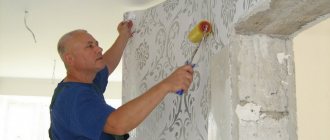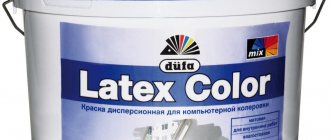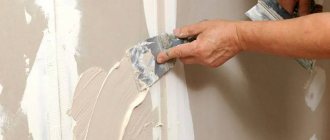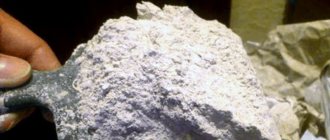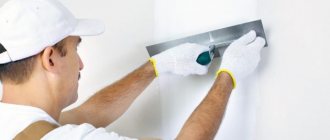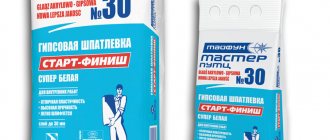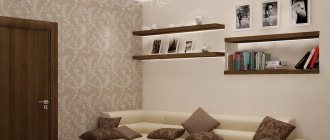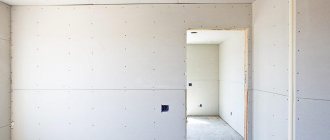Classification of putties
By degree of readiness
- Dry mixes
Dry putties are sold in bags or bags and have a lower cost compared to ready-made mixtures. The advantage of dry mixtures is their convenient transportation and storage. They also have a fairly long shelf life. Dry mixtures for the putty process can be prepared in the quantity and viscosity required at this stage of work. However, it is worth noting that the mixture prepared from dry putty must be used in a fairly short time. In addition, the dry mixture must be prepared strictly following the instructions indicated on the packaging and for its preparation you must have special tools.
- Ready-made putties
They are sold in buckets or jars, in ready-made form, which is quite convenient, since ready-made putties do not require preparation time or technology. Such putties have a fairly long shelf life.
The disadvantages of ready-made mixtures include their high cost and tendency to shrink, which does not allow their use in layers whose thickness exceeds 5 mm. Ready-made putties are based on new generation dispersions or latexes.
By binder
Putties are also classified according to the binder used:
- Cement
- Plaster
- Polymer
In addition, putties are moisture-resistant and non-moisture-resistant, for facade and interior work, as well as starting, finishing and universal putties. Basically, all putties differ in the degree of whiteness and evenness of the finished surface, and this depends on the size of the filler fraction. The smoothest surface can be achieved when using mixtures with a fine fraction. However, do not be afraid of such a wide variety of types and purposes of this material, because in any hardware store an experienced sales consultant will always be able to tell you which putty to choose. It is important to correctly explain what type of work is planned to be done.
Video about which putty is better: dry or ready-made?
Features of puttying with a polymer composition over paint
It is not recommended to apply putty on painted surfaces. If possible, it is better to remove as much old paint as possible. If this is not possible, you must:
- check the strength of the paint;
- clean the surface in places where it is chipped and rub it with a paint brush;
- prime;
- putty with a polymer compound.
There is also cement-based putty. However, when working with it, it is impossible to obtain a perfectly flat surface. However, it does not adhere well to painted, wooden and plastic surfaces.
The paint must be cleaned off before finishing work.
Having studied comprehensive information about the difference between polymer and gypsum putty, you can safely purchase the desired mixture in paper packaging or plastic containers and begin repair work. The finishing will be of high quality if you follow the tips and recommendations given in this article step by step.
What do you think about the difference between gypsum and polymer putty? Share in the comments!
Which putty and in what case is it better to choose?
The choice of type of leveling mixture depends on the base material.
Wooden surfaces
To prepare the wood surface for finishing, polymer compounds are used. They have excellent adhesion to plywood or chipboard, but before applying putty. the wood should be treated with antiseptic impregnations.
Drywall
In living rooms and office spaces, a standard gypsum mixture is usually used for leveling. To process drywall, it is not necessary to apply a starting layer, but before finishing it is necessary to seal the seams and the points where the sheets are attached. The joints are opened at an angle of 45 degrees, sickle tape is glued on and filled with putty.
The use of expensive polymer mixtures is recommended only in rooms with high humidity, where moisture-resistant drywall is installed.
Concrete
To level concrete and brick walls and ceilings, you can use any type of mixture, but you should take into account the operating conditions of the premises. For rooms with humidity above normal, polymer materials are suitable, and for rooms with normal humidity, gypsum-based leveling mixtures can be used.
For outdoor work, only acrylic-based polymer compounds are used.
Putty application technique
The solution is applied after cleaning the surface of old materials, treating with antiseptics and priming.
The work includes the following stages:
- preparation of solution;
- applying the mixture;
- grouting surfaces.
The work requires a container for mixing the components, an electric drill with an attachment, a set of spatulas, a paint float, a trowel, and sheets of sandpaper.
1 - mixing the solution
First you need to prepare a solution; the proportions for different compositions may differ. Manufacturers indicate the parameters on the packaging. The powder is gradually poured into the water in the container, and the solution is mixed by hand. Then, after reaching a thick consistency, kneading is done using an electric drill with a mixing attachment.
After mixing, the polymer solution is infused for 10-15 minutes. After 3 minutes, the gypsum composition is mixed a second time, the product is ready for application without infusion.
2 - applying the solution
The gypsum-based solution is applied to the wall panels with a wide spatula. When finishing the ceiling, it is recommended to use reinforcing mesh to create an even layer. The thickness of the base coat is up to 5 mm, the finishing layer should not exceed 3 mm.
The polymer composition has a thicker consistency, so a medium-sized spatula is used for application. The layer should be up to 3 mm thick; with a denser coating, the composition will be unevenly distributed and deformed. The final coating should be up to 1 mm thick. When working, the spatula must be held at an even angle to the surface. Movements for applying the mass are performed from bottom to top.
3 - surface grouting
Done in 4-6 hours. The work is carried out with a paint brush or fine sandpaper. Movements should be light and without pressure to prevent damage to the finishing material. Rubbing is performed in a circular motion with equal pressure.
The nuances of filling the base for different purposes
When filling surfaces for various tasks, the following nuances are taken into account:
- Surfaces for wallpapering are treated with 3 layers of base solution.
- Wall panels, ceilings, slopes for painting are treated with 2 layers of base solution, a layer of fiberglass and finally 3 layers of finishing material.
- Before applying a decorative coating with a rough texture, 2 base layers are required, fixation of a thin reinforced mesh and a base coat on top.
- When finishing with decorative materials with a fine texture, 2 base layers, a reinforcing mesh and 3 finishing coatings are required.
- When preparing plasterboard floors for painting, you will need to seal the seams and apply 3 finishing coats.
- To finish the loggia, facade surfaces, and basements, you will need to apply 3 layers of a universal composition for facades.
Which putty is better - gypsum or polymer?
The result of the finishing work performed depends on the quality of the material used.
Gypsum putty
Gypsum-based putty is used for interior finishing of surfaces made of plasterboard, gypsum fiber and cement. It is used in cases where it is necessary to level out surface defects, eliminate unevenness and mask joints. Gypsum putty gives surfaces ideal evenness and smoothness, and makes them ready for such types of finishing as painting or wallpapering. In addition, various decorative elements of the interior, for example, columns or arches, are finished with gypsum putty. Gypsum plaster has moisture-resistant properties, which allows it to be used for finishing bathrooms and other rooms with high humidity.
Gypsum putty is made from gypsum and is sold in powder or paste form. On the market you can find putties that contain white gypsum or gypsum with a yellowish tint. In addition, they contain various additives of water-soluble polymers and mineral fillers, for which manufacturers use marble flour or white quartz sand. The size of the filler fraction determines the purpose of the gypsum putty - starting or finishing. The final property of the material depends on such components of gypsum putty as modifiers and plasticizers, which protect the surface from cracking and crumbling.
Polymer putty
Polymer putties contain Portland cement, plasticizers, polymers and are mainly used in rooms with a low percentage of humidity. There are both starting and finishing polymer putties. Their feature is the rapid hardening of the applied mixture to the surface.
Video about which putty is better: gypsum or polymer
- Unlike gypsum, polymer putty, when used in rooms with high humidity, contributes to disruption of the microclimate and retention of moisture in the room, while gypsum-based mixtures maintain humidity at the proper level.
- Also, polymer putty differs from gypsum in lower vapor permeability and weaker ductility.
- In addition, polymer putties contain synthetic components, while gypsum putties are an environmentally friendly material.
- And finally, polymer putties are more expensive than gypsum putties.
Having studied the features of these mixtures, we can conclude which putty is better - gypsum or polymer for a specific task.
Which is better - gypsum or polymer mixture?
In the process of interior finishing work, many consumers ask themselves the question: which putty is better - gypsum or polymer? This question does not have a clear answer, because each of these materials has its own pros and cons. And is it possible to compare two completely different mixtures? Most importantly, before making a choice in favor of any of them, you need to take into account the following features of the room being renovated:
- Humidity. If there is high humidity in the room (bathroom, kitchen, veranda), preference should be given to polymer materials. By absorbing moisture, gypsum-based mixtures swell on the walls and begin to fall off.
- Temperature swings. Gypsum mixtures cannot withstand sudden temperature changes, deforming and cracking. Therefore, in this case, you should opt for polymer putty.
- Mechanical influences (vibration). This can lead to the plaster coming off the wall, so again we choose polymer putty.
If the repair is carried out in a dry and warm room, you should pay attention to the gypsum mixture, the difference of which is its affordable price. Remember that high quality material is the key to safety and comfort.
Walls that have been treated with gypsum or polymer mortar acquire a number of positive characteristics:
- do not have a characteristic chemical smell;
- environmentally friendly;
- are not subject to deformation due to the elasticity of the composition;
- fireproof and fire resistant;
- have good sound insulation;
- have protection against fungus and mold.
Thanks to putty, you can level any surface and prepare it for wallpapering or painting. The key to an ideal result is high-quality material and application in compliance with all stages. You just need to carefully study the technology.
Which putty is best for drywall?
When starting finishing work on drywall, the question may arise as to which putty is best for drywall and how to choose it correctly. To do this, you should know that when working in rooms with frequent changes in humidity, such as the kitchen and bathroom, it is better to use cement putty.
Polymer putties are also well suited for puttying drywall, since they have significantly lower consumption and high ductility.
Also, in rooms where there are no significant changes in humidity, drywall can be finished using putties based on cement, gypsum, and polymer materials. Since it does not matter what kind of putty to use for ceilings or plasterboard walls, you can opt for universal dry mixes, since they are more convenient to use and have a low cost.
Advantages of polymer putty
There are three types of this material: latex, acrylic and polymer cement putty. Each of them is suitable for interior work. For external ones, you should choose an acrylic or polymer-cement base. Artificial materials (acrylic, latex) are responsible for the connection between the components of the solution. It is used sparingly, is applied evenly, and it is very convenient to work with such material.
The main advantages of polymer putty:
- suitable for any surface (concrete, covered with plasterboard, brick, plastered);
- increased adhesion to the treated surface;
- moisture resistance;
- has no smell;
- high vapor permeability;
- dries evenly;
- increased strength characteristics;
- environmentally friendly, contains no harmful impurities;
- resistant to temperature changes;
- does not contribute to the formation of cracks;
- does not deform when drying;
- does not require special skills for application;
- resistant to chemicals;
- when diluted, it is stored for 12 hours (if the container with the solution is closed);
- hardens quickly on the surface.
A polymer finishing is often used, because after applying the solution the walls are white, perfectly smooth and protected from cracking, shedding and exposure to adverse factors (water, chemicals, mechanical stress, temperature changes, etc.).
Do not apply polymer putty to wooden or metal surfaces due to poor adhesion. There are specialized materials for this.
Which putty is better - latex or acrylic?
Latex putty
Latex putty is quite popular among professional builders due to its positive technical characteristics.
Such putties consist of plasticizers, antiseptics, binders, hardeners and polymers. The latter allow you to protect walls from high humidity. Latex-based compositions are environmentally friendly and odorless.
Latex compounds can be applied in very thin layers without losing the strength characteristics of the material. In addition, you can find a large selection of different colors on sale. Latex putties have an advantage over acrylic putties, which is that purchasing a latex composition of the required color will help you avoid unnecessary costs for purchasing special dyes. Working with ready-made compounds is quite convenient due to their elastic consistency.
In addition, latex putties are characterized by high adhesion to any substrate and work on the principle of liquid rubber, perfectly leveling all surfaces and adhering tightly to them.
When latex putty hardens, a film that does not crack or crumble is formed, which distinguishes it from acrylic-based compositions.
The disadvantage of latex-based compositions is their high cost and fear of low temperatures, since when latex putty is stored below 0C˚, its properties will deteriorate significantly, making it impossible to work with the composition.
Acrylic putty
Acrylic putty is used, as a rule, when it is necessary to make “artistic finishing” of the ceiling and walls. These mixtures are also used for finishing surfaces such as concrete, foam concrete, and wood. Acrylic putty is used for both interior and exterior work. There are starting and finishing mixtures based on acrylic. This type of putty is applied in a thicker layer, unlike latex-based compounds, since if it is applied in a very thin layer, the strength characteristics of the material will be lost. Acrylic putty allows you to achieve an almost mirror effect on the surfaces of walls or ceilings.
The advantage of acrylic-based putties is their high strength and moisture resistance. There is such a type of acrylic putty as acrylic latex, which contains silicone.
Having studied the features of these types of mixtures, each master will be able to draw the appropriate conclusion for himself which putty is better - latex or acrylic and choose the one that is best suited for this or that type of finishing work.
Compatibility of polymer and gypsum putties
Before applying a polymer composition to gypsum, you should familiarize yourself with the opinions of experts:
- It is not recommended to apply a composition with a high pH content to a composition with a lower pH content;
- It is not recommended to apply a more durable material to a less durable one;
- The lower moisture permeability of the outer layer can cause peeling if the lower layer is not dry enough.
The conclusion that follows from the above is that you should not apply the polymer composition to the gypsum base.
Most experts do not recommend applying polymer putty to gypsum.
What are putty mixtures made of?
The product contains three main components. First, an astringent powdery substance. After mixing with water, it turns into a paste and then into a solid state. Secondly, the filler, which is most often ground marble, limestone, and chalk. And thirdly, modifying additives that improve the properties of the solution. By the name you can immediately understand which substance in this product is the binder: in cement - cement, in gypsum - gypsum, in polymer - polymers.
Cement
Cement mortars create a durable, water-resistant layer, and therefore are good for decorating facades, walls and ceilings in bathrooms, swimming pools and other rooms with high humidity levels. They will become a reliable basis for facing with ceramic tiles and porcelain stoneware. It becomes clear which putty to choose for the bathroom. However, the cement layer often shrinks or cracks during the drying process, especially if the work technology is violated.
Gypsum
Gypsum pastes, unlike cement pastes, are afraid of moisture and do not like temperature changes. However, they form a smoother surface and dry quickly without shrinking or cracking. Plaster on walls and ceilings allows air to pass through well. This leveling compound is suitable for dry rooms. It is used for wallpaper or painting.
Application of polymer mixture
When applying polymer putty, the most important thing is to adhere to the basic rules:
1. Apply the solution only to the prepared wall. It is necessary to remove dirt, grease stains, mold, etc. To degrease walls, gasoline or acetone is recommended. This is a very important stage, on which the adhesion of the putty to the surface completely depends.
2. Pre-treat the wall with a primer that contains antiseptics, which will be the best prevention of the formation of mold or mildew in the future. A primer is also needed for better adhesion of the solution to the surface.
3. Dilute the putty as described in the instructions. The finished solution should not spread, but remain plastic.
4. Apply the polymer mixture to the wall with a spatula (no thicker than 3 mm) and after drying, sand it with coarse sandpaper.
5. Apply a layer of primer again. Repeat alternation until the finishing layer.
6. If there is a finishing layer: after some time, treat the surface with sanding paper (zero). Using circular movements, it is easy to achieve a perfectly smooth snow-white surface.
If you strictly follow the sequence when performing work, you can achieve perfectly smooth walls that will not need alteration or restoration for many years.
Applying gypsum mortar
The layer of gypsum material is much thicker; serious flaws can be quickly eliminated with its use. A single application layer of no more than 1 mm to avoid possible cracks. The polymers are applied in a very thin layer, which virtually eliminates the possibility of eliminating large defects. This is possible, but it will be very expensive and too expensive.
Important! Gypsum mixture and polymer-based putty are applied in different layers when working on the surface of the walls.
Gypsum putty is ideal for applying the starting leveling layer. Having thoroughly cleaned the walls of dirt and primed them with a deep penetration agent, you can begin applying the solution:
Related article: Types of epoxy putty and areas of its application
1. If you are puttingtying drywall, you need to cover with the mixture the joints of the drywall sheets and the holes above the screw heads. To do this, you must first stick a sickle mesh onto the treatment areas.
2. When finishing surfaces of poor quality, they are treated with a wide spatula, applying several layers of mortar.
3. Before laying the next layer, it is necessary that the previous one becomes completely dry. The last layer is sanded using a special grater with an abrasive cloth. Sandpaper is also suitable for these purposes.
Dry and wet mixtures
Putty materials are produced in the form of dry powders or as a finished product. In the first case, the contents of the package are poured into a container with water, observing the proportions specified by the manufacturer (usually about 0.3 liters per 1 kg of powder). Then stir with a construction mixer at low speed until a homogeneous mass is obtained. Let it brew for 5-10 minutes and repeat the procedure until a homogeneous, lump-free solution is obtained.
The finished mass is mixed in production in special homogenizers, which guarantee the homogeneity of the solution and the absence of lumps, unmixed substances, and clots. By the way, filler of the smallest fractions (0.02-0.1 mm) is used to make the product. When applied, the thinnest, most even layer is formed, which ensures optimal consumption.
If you use inexpensive options, sometimes when combining an already puttied area with a new one, a noticeable and difficult to process joint can form. High-quality solutions are distinguished by high plasticity: the mixture stretches behind a spatula and is easily leveled. Craftsmen value them for their ease of application and perfect mixing of layers, which subsequently guarantees uniform and economical distribution of paint. All tools used during puttying must be made only from stainless materials.
Main characteristics of gypsum putty
This putty is based on gypsum, or alabaster, which has either a white color or a slightly yellowish tint. Polymers that are completely water-soluble and mineral fillers are also added, these usually include either marble flour or white quartz sand.
Fillers have different fractions, depending on what role the putty will perform: starting or finishing. The starting composition is coarser and coarser-grained, as it is intended to eliminate significant cracks, surface differences, and joints. They cover large defects in the surface of the walls.
The finishing mixture is used to finally smooth out any uneven surfaces, so it has a fine-grained consistency. To ensure that the surface treated with this building material does not crack or crumble, a number of modifiers and plasticizers are added to it.
Gypsum-based putty is used to level surfaces, eliminate complex defects, and mask cracks and joints. After making the walls smooth, you can begin finishing in the form of painting and wallpapering. Putty is used to decorate the interior of the room. It is suitable for arranging and finishing columns, interior passages in the form of arches, decorating ceilings and cornices with stucco.
The use of gypsum putty and its varieties
Gypsum putty is produced both in the form of dry mixtures, packaged in bags or packages, and already prepared for use in jars and buckets. The material in dry form is convenient for transportation and can be stored for a long time. It is prepared in the quantity required at this stage of work, but it must be used quickly, within half an hour from the time of preparation. It is necessary to prepare a solution from a dry mixture in accordance with the instructions.
Ready-made mixtures made using new generation dispersions or latexes are convenient because they do not require time to stir. But they have one drawback: they are prone to slight shrinkage.
Main characteristics of polymer putty
Polymer-based putty is created chemically with the addition of mineral substances and is used for application to any surface, including concrete, plaster, drywall, because it has a high degree of connection with surfaces. Particularly attractive in this type of material are qualities such as resistance to moisture and high strength. These mixtures are irreplaceable in finishing rooms with high moisture content, kitchens, bathrooms.
Polymer putty is often used for finishing because it leaves the walls looking smooth and pure white, requiring almost no painting. Once it hardens, the surfaces will be protected from cracking and peeling. Polymers are insoluble in water and can withstand mechanical stress, low temperatures, and chemicals.
Mixing the ready-to-use mixture
Ready-made polymer-based solutions already have the required consistency, so they are not diluted with water to prevent the bonds between molecules from being broken. If they are in a tightly sealed container, then their shelf life is quite long, and even after they have been used, they may not lose their properties, but only at normal air temperatures.
Dry mixtures are diluted according to instructions, and if ready-to-use materials are stored in a hermetically sealed container, they remain viable for five days. Excess water in such solutions is just as harmful as too little: it should be 3-5 percent, about a liter of water per 25 kilograms of dry mixture.
What to choose: gypsum or polymer putty?
The difference between polymer putty and gypsum putty
The difference between polymer putty and gypsum putty can be assessed from the table:
| Putty | Plaster | Polymer |
| Vapor permeability | low | high |
| Moisture resistance | low | high |
| Plastic | high | average |
| Adhesion (stickiness) | high | high |
| Environmental friendliness | high | there are chemical components |
| Price | low | average |
| Hardening | fast | slow |
| Hue | with yellowness | pure white |
| Strength | average | high |
| Temperature loads | + 800ºС | short |
The table shows the difference between the mixtures, so it will be easier for a novice master to decide on a purchase.
The strength indicators of the polymer composition are greater than gypsum


